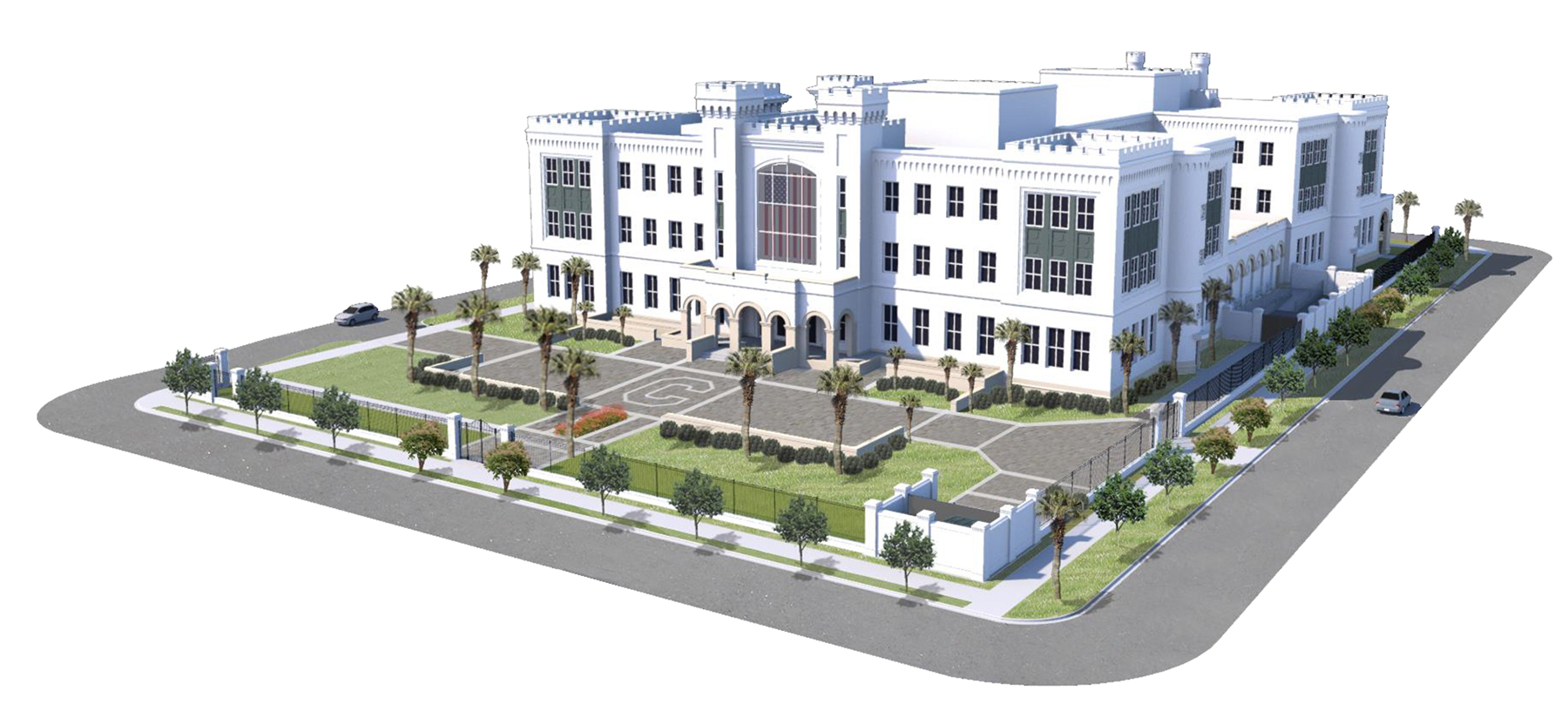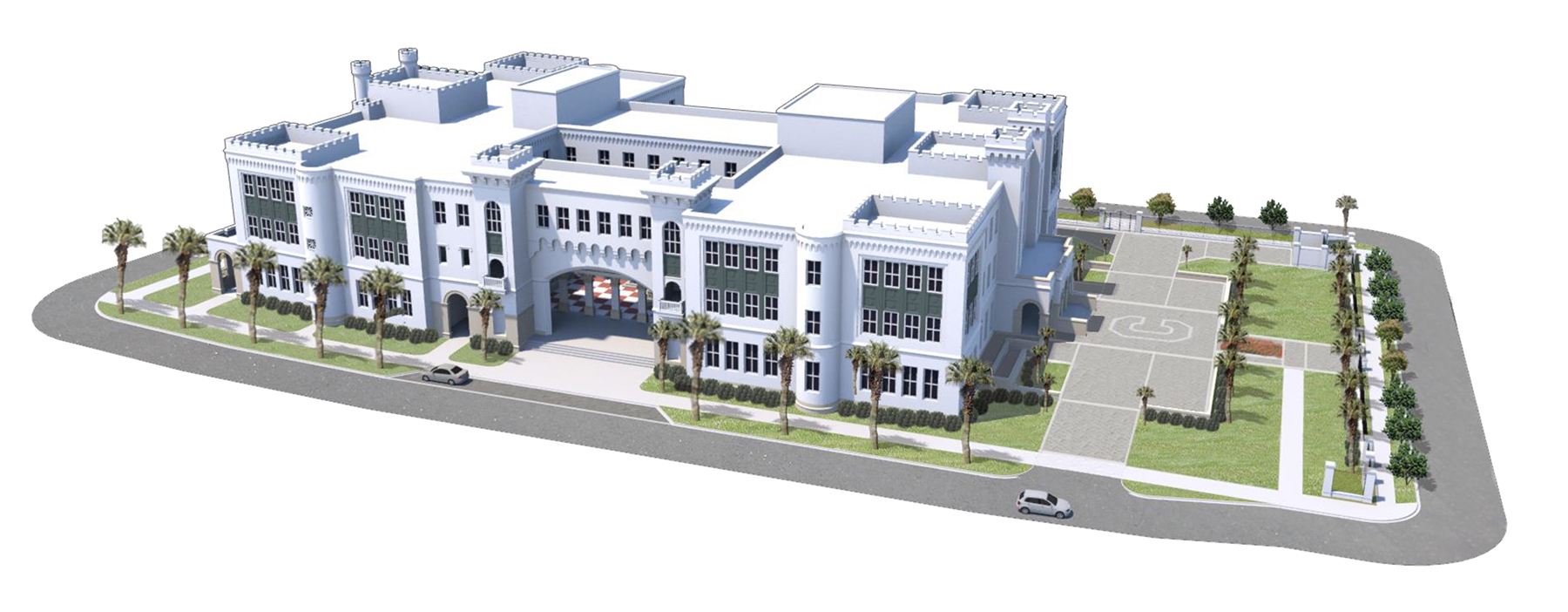By Robert L. Reid
The Citadel in Charleston, South Carolina, is a difficult site for structural design because the region exposes buildings to a series of potential challenges, including poor soils, a high water table, seismic events, and hurricanes, explains Jimmy Jones, P.E., a partner and project manager in the Columbia, South Carolina, office of ADC Engineering. ADC is responsible for the structural and civil engineering of the Capers Hall Replacement Project at The Citadel, which had to consider each of these challenges in the design of a new academic building planned for the military college.
ADC employs several engineers who are Citadel graduates, including Jones, who notes that “it’s nice to give something back” to his alma mater.
The $67 million effort will replace the existing Capers Hall — a three-story, 75,116 sq ft structure that was erected in the 1950s and expanded in the 1970s — with a new facility designed to meet the requirements of modern building codes and provide “21st-century educational upgrades to meet the needs of modern students,” explains a press release from Woolpert, the national architecture, engineering, and geospatial firm leading the project. Woolpert, which has an office in Charleston, is the project’s architect of record and is providing landscape architecture, interior design, and engineering services.
The new Capers Hall will also be three stories tall but will increase the overall size of the facility to 107,700 sq ft by enclosing a larger footprint. The original Capers Hall was L-shaped in plan, says Jones, while the new building will be an open rectangle that surrounds a courtyard. It will contain flexible classrooms and collaborative workspaces, computer classrooms and a digital media lab, a cyber lab and secure work area for cyber intelligence and security studies, a 250-seat performing arts auditorium, and other amenities.

While the college was founded in 1842 at a different site, the current campus on the banks of the Ashley River was constructed in 1922. Like most buildings at The Citadel, the facade of the new Capers Hall will feature a Moorish aesthetic of turrets and castellations. The architectural detailing will be formed from a high-density structural foam clad in white stucco. The new building’s interior courtyard will also be covered in a checkerboard pattern of red and white pavers that is used throughout the campus, notes Jones.
Creech & Associates PLLC, which has offices in Charlotte, North Carolina, and Mount Pleasant, South Carolina, is the project’s design architect. DWG Consulting Engineers, based in Mount Pleasant, is responsible for the mechanical, electrical, and plumbing engineering and fire protection.
Replace or restore?
The Citadel had been planning to either restore or replace Capers Hall for a number of years, Jones says, but ultimately determined that replacement was the best option in terms of costs, the amount of work required, and the college’s desire for a modern facility.
Because of the site’s soil conditions, which feature soft and loose sands at risk of liquefaction, the new building is being founded on prestressed, precast concrete piles, generally 12 to 14 in. square and between 75 and 85 ft in length to reach a dense layer of Cooper Marl clay, explains Jones.
The original building had been founded on a mix of timber and concrete-filled pipe piles that had to be left in place because of the difficulty in removing them, says Jones. The exact location of the old piles was not well known, he adds, so ADC had to wait to complete the design of the new foundation system until the contractor — Thompson Turner Construction, of Sumter, South Carolina — had demolished the existing buildings and exposed the original supports.
Based on ADC’s experience with other projects in the Charleston area, the engineers knew that the as-built locations of the old piles could vary significantly from what was on the original documents, Jones says.
The new piles will support a heavy structural slab measuring between 8 and 10 in. thick that will be elevated about 4 ft above grade because the site is in a flood zone, Jones says. The slab will slope 3 to 6 in. beneath the finished floor elevation for the ground floor auditorium space to accommodate tiered seating, which made the design even more challenging, Jones adds.
The foundations will also feature concrete grade beams, a perimeter stem wall, and a backfill of soil beneath the slab.
Steel superstructure
The new steel superstructure will utilize special moment frames with prequalified reduced beam section connections to accommodate the site’s wind and seismic loads. “In a prequalified reduced beam section connection, portions of the flange are strategically removed in the region adjacent to the column,” Jones explains. “The reduced section forms a ‘fuse’ that will inelastically deform in a ductile manner in a significant seismic event, which helps to dissipate energy. The creation of a fuse in the beam with very precise and controlled geometry provides for a very predictable behavior that protects against collapse by ensuring a strong column-weak beam relationship.”
Braced frames will also be used in select locations, such as the building’s turrets, Jones notes. A transfer truss will be used to accommodate the large, open spans of the auditorium, he notes.
While a series of transfer trusses at multiple levels of the building was first considered, the final design features a one-story tall vierendeel truss in which the bottom chord is located at the second floor and the top chord is located at the third floor. This truss will be embedded within the building’s exterior wall. To accommodate the architect’s plans for a series of windows running across the facade, there will be no diagonal members in the truss, Jones adds.
The new Capers Hall has been designed to achieve a silver certification under the Leadership in Energy and Environmental Design standards created by the U.S. Green Building Council. The project’s LEED-focused plans include a roof-mounted solar array that will be anchored directly to the roof deck, which will need to be robust enough to support the weight of the solar panels and prevent them “from flying off the building” in hurricane winds, Jones says.
Civil side
Most of an existing asphalt parking lot will be incorporated into the footprint of the new building. In its place, the project will create a new parking area and outdoor gathering space that features permeable pavers to help reduce stormwater runoff from the site, notes Chris Cook, P.E., M.ASCE, a partner in ADC’s Hanahan, South Carolina, office. Cook is also a Citadel graduate.
Other stormwater improvements — already completed at publication time — include the demolition and reconstruction of a drainage pipe that had passed directly beneath the original Capers Hall but which has now been routed around the site of the new building, Cook says. An old storm drainage system on the streets adjoining the campus was also replaced because it was undersized and in poor condition, Cook notes.

Moreover, an existing sanitary sewer system in the area that had passed through part of the existing drainage system, creating a potential conflict with the new drainage works, has been separated from that system using dual elliptical pipes, Cook says. New vortex separators that help eliminate sediments and trash from the water flows will be installed as a water quality improvement measure, he adds. The sediment will be collected and mostly landfilled.
Because the larger footprint of the new Capers Hall created a conflict with existing electrical and communications duct banks, those systems will be relocated to new underground settings. As a result, the sidewalks and streetlights in the area will have to be replaced and new trees planted, Cook adds.
At publication time, the piles for the foundations of the new Capers Hall had been driven and the erection of structural steel had begun.
The project is expected to be completed in time for the 2023 fall semester.



